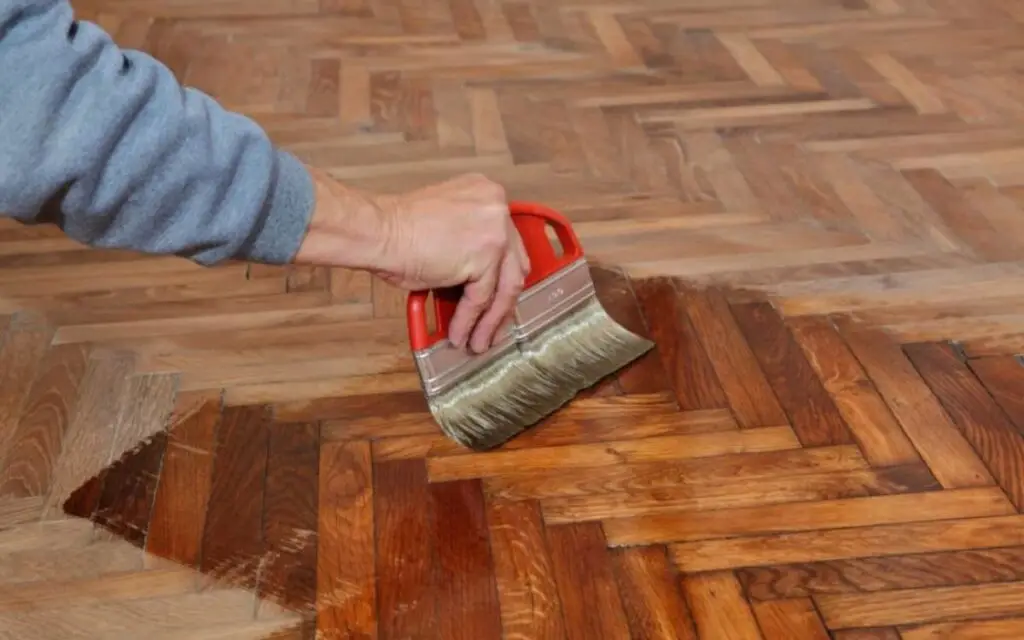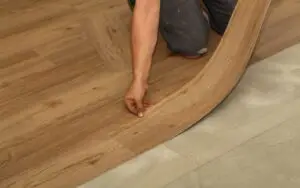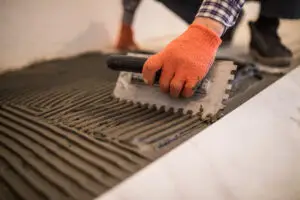The Importance of Sanding Before Staining
Why Sanding is Necessary
Removing Existing Finishes
One of the main reasons why sanding is necessary before staining wood floors is to remove the existing finishes, such as polyurethane or varnish. These finishes create a barrier that prevents the new stain from properly penetrating the wood. Without removing this barrier, the new stain will not adhere correctly and will likely peel or flake off over time. Professional installers know that proper sanding is the first, and one of the most important, steps in any stain job.
Smoothing the Surface
Sanding also helps smooth the wood surface, eliminating imperfections and creating an ideal surface for staining. Even if your floors appear smooth, there are often microscopic imperfections that can prevent the stain from being absorbed evenly. The sanding process removes these imperfections, ensuring that the stain will be absorbed consistently for a smooth, and beautiful final result.
Opening Wood Pores
Sanding opens the pores of the wood, allowing the stain to penetrate more deeply and evenly. This is especially important with dense hardwoods that have tight wood grains. When the wood pores are open, the stain will penetrate deeply, which will help to achieve the desired color, while also providing an extra level of protection that is also long lasting.
Risks of Staining Without Sanding
Uneven Stain Absorption
Staining wood floors without sanding can lead to uneven stain absorption. The existing finish will block the stain from penetrating in some areas, while other areas might absorb more stain, which will result in a blotchy and inconsistent appearance. This uneven finish will reduce the overall beauty of your floors, and is very common in DIY projects.
Poor Adhesion of Stain
Without sanding, the new stain will not adhere correctly to the wood, and will most likely peel or flake off over time. This will not only ruin the look of your floors, but will also create a situation where repairs and a re-stain will be needed much sooner than expected. Professional installers know that the proper sanding is essential for long lasting results.
Unsatisfactory Finish
Skipping the sanding step will almost always lead to an unsatisfactory finish, that will look unprofessional and have a shorter life span. The stain will not adhere correctly, the color will be inconsistent, and the overall result will be less than optimal. If you want a professional-looking, and long-lasting stain, then proper sanding is required, which is best left for the professionals.
Understanding the Sanding Process
Types of Sanding Equipment
Drum Sanders
Drum sanders are powerful machines that are used for the initial sanding of wood floors. These sanders are extremely powerful, and require the proper training and knowledge for safe and effective use. This type of equipment is most often used by professional installers, and will usually be too expensive to rent or purchase for most DIYers.
Orbital Sanders
Orbital sanders are used for finer sanding and to smooth the surface after using a drum sander. These sanders move in a circular motion, which allows for a smooth, even, and consistent finish. The orbital sander is an essential tool for professional installers, and is used to ensure that each floor is perfectly smooth and ready for staining.
Edge Sanders
Edge sanders are used to sand the edges of the room, and other difficult to reach areas. These tools are very helpful for sanding near walls and other obstructions, ensuring that the entire floor is perfectly sanded. This type of equipment is essential to professional installers, as they are used to ensure that every square inch of the floor is prepared correctly.
Sanding Steps
Coarse Sanding
The first step in sanding wood floors is to use a coarse grit sandpaper. This step is used to remove the existing finish, and level the floor. Coarse sanding requires care and precision, because you do not want to over-sand the floor, which can lead to imperfections. Professional installers are well-trained in this crucial step, and will always ensure a level surface to begin the staining process.
Medium Sanding
After the initial coarse sanding, you will need to use a medium grit sandpaper to further smooth the surface and remove any imperfections. This step helps to prepare the floor for finer sanding and staining. Professional installers are very precise with this step, and always ensure a perfectly smooth finish for an optimal final result.
Fine Sanding
The final step in the sanding process is fine sanding. Fine sanding will further smooth the surface, and prepare the wood for optimal stain absorption. This step will ensure an even, and consistent appearance, which is the goal for any high-quality wood floor stain job. Professional installers are very meticulous with this final sanding step, because they understand the importance of a perfectly prepared surface.
DIY vs Professional Floor Sanding
Challenges of DIY Sanding
Potential for Damage
DIY sanding can easily lead to damage to your wood floors. It is easy to over-sand the floors, creating an uneven surface, or gouges in the wood. It is also possible to under-sand the floors, which will result in an uneven stain job. Because of all of the things that can go wrong, it is usually best to leave floor sanding to the professionals.
Uneven Sanding Results
DIYers often have difficulty achieving even sanding results. Using the wrong equipment, incorrect techniques, and incorrect pressure are all very common with DIY floor sanding. These uneven results will almost always lead to an uneven and unprofessional looking stain job. A professional floor sanding service will always ensure even and consistent results.
Time and Effort Required
DIY floor sanding is a time consuming and labor intensive project, that often requires more time and effort than anticipated. The process requires a lot of preparation, hard work, and the proper knowledge, all of which most DIYers do not have. Professional installers can complete the job much faster and more efficiently, with no hassles, or stress.
Benefits of Professional Sanding Services
Expertise and Precision
Professional wood floor sanding services provide expertise and precision. They know which techniques, and tools are best to use for any specific situation. They are also well-trained and familiar with any potential issues, and they know how to overcome them, ensuring the very best results.
Access to Professional Equipment
Professional installers have access to high-quality, industrial-grade sanding equipment, which provides a more efficient, and superior result. These professional tools are very expensive to rent or purchase, and usually only accessible to professional services. These tools are essential for a high-quality sanding job, and for a beautiful and long lasting stain.
Efficiency and Quality
Professional installers know how to sand wood floors quickly and efficiently, with high-quality results. Their experience and knowledge allows them to complete the job quickly, and with minimal disruption to your home or business. This is a benefit that most DIYers will not be able to achieve.
Case Studies: Sanded vs. Un-Sanded Floors
Example of Poor Staining Without Sanding
A homeowner attempted to stain their wood floors without sanding to save time and money. However, without proper sanding, the new stain did not adhere correctly, and the result was an uneven color with a blotchy appearance, that looked unprofessional. The homeowner was extremely disappointed, and then had to hire a professional to correct their mistake, costing them more than if they had hired a professional in the first place.
Example of a Professional Sanding and Staining Job
Another homeowner hired a professional wood floor sanding and staining service. The professional installer used the correct tools, and techniques, to properly prepare the floor for stain. The stain was applied evenly and consistently, with the result being a beautiful, durable, and long lasting floor, that the homeowner was extremely happy with.
FAQs & Answers
Sanding wood floors before staining is absolutely necessary because it removes existing finishes, smooths the wood surface, and opens up the wood pores. This process ensures that the new stain is absorbed evenly, and that a high-quality, long-lasting finish is achieved. Professional wood floor sanding is essential to a successful stain job, as DIY jobs often end up blotchy, and uneven.
If you skip the sanding step before staining wood floors, you risk an uneven application, poor stain adhesion, and an unsatisfactory final result. The existing finish will prevent the new stain from properly penetrating the wood, resulting in a patchy appearance and a finish that is prone to peeling and chipping. Professional installers understand that proper sanding is an absolutely necessary step.
Common DIY mistakes in wood floor sanding include using the wrong equipment, applying uneven pressure, over-sanding, under-sanding, and failing to properly clean the dust from the surface. These mistakes can lead to damage and uneven staining, which is why most homeowners choose a professional floor sanding service. Professionals are well-trained to prevent all of these issues.
Professional wood floor sanding services use industrial grade equipment such as drum sanders, orbital sanders, and edge sanders. They also use a variety of different grits of sandpaper, and specialized dust collection systems that will prevent dust from spreading in the work area. These types of equipment are very expensive to rent or purchase, which is why most DIYers choose professional services.
Professional wood floor sanding and staining services provide you with a high-quality, smooth, and even finish that will enhance the beauty and value of your home. They will also provide a durable and long lasting layer of protection. They have the tools, skills and experience to ensure that your floors will look great for years to come. Most importantly, professional installers stand behind their work, and offer a warranty that is not available with a DIY job.





